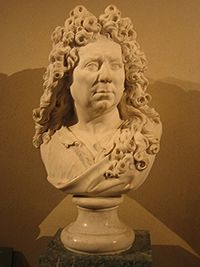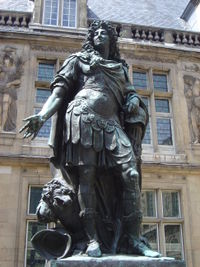
Antoine Coysevox
Encyclopedia


France
The French Republic , The French Republic , The French Republic , (commonly known as France , is a unitary semi-presidential republic in Western Europe with several overseas territories and islands located on other continents and in the Indian, Pacific, and Atlantic oceans. Metropolitan France...
sculptor
Sculpture
Sculpture is three-dimensional artwork created by shaping or combining hard materials—typically stone such as marble—or metal, glass, or wood. Softer materials can also be used, such as clay, textiles, plastics, polymers and softer metals...
, was born at Lyon
Lyon
Lyon , is a city in east-central France in the Rhône-Alpes region, situated between Paris and Marseille. Lyon is located at from Paris, from Marseille, from Geneva, from Turin, and from Barcelona. The residents of the city are called Lyonnais....
, and belonged to a family which had emigrated from Spain
Spain
Spain , officially the Kingdom of Spain languages]] under the European Charter for Regional or Minority Languages. In each of these, Spain's official name is as follows:;;;;;;), is a country and member state of the European Union located in southwestern Europe on the Iberian Peninsula...
. The name should be pronounced quazevo.
Biography
He was only seventeen when he produced a statue of the Madonna of considerable merit; and having studied under Louis LerambertLouis Lerambert
Louis Lerambert was a French sculptor in a numerous Parisian family of four generations of court artists who in 1637 inherited the court position caring for the Antiquities and Marbles of the King, which had become hereditary in his family...
and having further trained himself by taking copies in marble from Roman
Ancient Rome
Ancient Rome was a thriving civilization that grew on the Italian Peninsula as early as the 8th century BC. Located along the Mediterranean Sea and centered on the city of Rome, it expanded to one of the largest empires in the ancient world....
sculptures (among others from the Venus de Medici and the Castor and Pollux), he was engaged by the bishop of Strasbourg, Cardinal Fürstenberg
William Egon of Fürstenberg
William Egon of Fürstenberg was a German clergyman who was bishop of Strasbourg.He began his career as a soldier in the French service....
, to adorn with statuary his château at Saverne (Zabern).
In 1666 he married Marguerite Quillerier, Lerambert's niece, who died a year after the marriage. In 1671, after four years spent working at Saverne, which was subsequently destroyed by fire in 1780, he returned to Paris. In 1676 his bust of the king's painter Charles Le Brun
Charles Le Brun
Charles Le Brun , a French painter and art theorist, became the all-powerful, peerless master of 17th-century French art.-Biography:-Early life and training:...
obtained admission for him to the Académie Royale. A year later he married Claude Bourdict.
For niches on the façade of Jules Hardouin-Mansart's royal chapel at Les Invalides he was commissioned to produced a Charlemagne (illustration) as a pendant to Nicolas Coustou
Nicolas Coustou
Nicolas Coustou was a French sculptor and academic.Born in Lyon, Coustou was the son of a woodcarver, who gave him his first instruction in art. At eighteen he moved to Paris, to study under C.A...
's Louis XI. On the upper storey stand his Cardinal Virtues.
In consequence of the coordination of official arts that was exercised by Charles Le Brun
Charles Le Brun
Charles Le Brun , a French painter and art theorist, became the all-powerful, peerless master of 17th-century French art.-Biography:-Early life and training:...
between the years 1677 and 1685, he was employed on behalf of Louis XIV
Louis XIV of France
Louis XIV , known as Louis the Great or the Sun King , was a Bourbon monarch who ruled as King of France and Navarre. His reign, from 1643 to his death in 1715, began at the age of four and lasted seventy-two years, three months, and eighteen days...
in producing much of the decoration and a large number of statues for Versailles
Palace of Versailles
The Palace of Versailles , or simply Versailles, is a royal château in Versailles in the Île-de-France region of France. In French it is the Château de Versailles....
; and he afterwards worked, between 1701 and 1709, with no less facility and success, for the Château de Marly
Château de Marly
The Château de Marly was a relatively small French royal residence located in what has become Marly-le-Roi, the commune that existed at the edge of the royal park. The town that originally grew up to service the château is now a dormitory community for Paris....
, subsequently largely abandoned, then destroyed in the Revolution
French Revolution
The French Revolution , sometimes distinguished as the 'Great French Revolution' , was a period of radical social and political upheaval in France and Europe. The absolute monarchy that had ruled France for centuries collapsed in three years...
.


Château de Saint-Cloud
The Château de Saint-Cloud was a Palace in France, built on a magnificent site overlooking the Seine at Saint-Cloud in Hauts-de-Seine, about 10 kilometres west of Paris. Today it is a large park on the outskirts of the capital and is owned by the state, but the area as a whole has had a large...
and the Neptune and Amphitrite went to Brest in 1801.
In his portrait sculptures the likenesses were said to have been remarkably successful; he produced portrait busts of most of the celebrated men of his age, including Louis XIV and Louis XV
Louis XV of France
Louis XV was a Bourbon monarch who ruled as King of France and of Navarre from 1 September 1715 until his death. He succeeded his great-grandfather at the age of five, his first cousin Philippe II, Duke of Orléans, served as Regent of the kingdom until Louis's majority in 1723...
at Versailles, Colbert
Jean-Baptiste Colbert
Jean-Baptiste Colbert was a French politician who served as the Minister of Finances of France from 1665 to 1683 under the rule of King Louis XIV. His relentless hard work and thrift made him an esteemed minister. He achieved a reputation for his work of improving the state of French manufacturing...
(the kneeling figure of his tomb at Saint-Eustache
Église Saint-Eustache, Paris
L’église Saint-Eustache is a church in the 1st arrondissement of Paris, built between 1532 and 1632.Situated at the entrance to Paris’s ancient markets and the beginning of rue Montorgueil, the Église de Saint-Eustache is considered a masterpiece of late Gothic architecture...
), Cardinal Mazarin (in the church of the Collège des Quatre-Nations
Collège des Quatre-Nations
The Collège des Quatre-Nations , also known as the Collège Mazarin after its founder, was one of the colleges of the historic University of Paris. It was founded through a bequest by the Cardinal Mazarin...
), the Grand Condé
Louis II de Bourbon, Prince de Condé
Louis de Bourbon, Prince of Condé was a French general and the most famous representative of the Condé branch of the House of Bourbon. Prior to his father's death in 1646, he was styled the Duc d'Enghien...
(in the Louvre), Maria Theresa of Austria
Maria Theresa of Austria
Maria Theresa Walburga Amalia Christina was the only female ruler of the Habsburg dominions and the last of the House of Habsburg. She was the sovereign of Austria, Hungary, Croatia, Bohemia, Mantua, Milan, Lodomeria and Galicia, the Austrian Netherlands and Parma...
, Turenne
Henri de la Tour d'Auvergne, Vicomte de Turenne
Henri de la Tour d'Auvergne, Vicomte de Turenne,often called simply Turenne was the most illustrious member of the La Tour d'Auvergne family. He achieved military fame and became a Marshal of France...
, Vauban
Vauban
Sébastien Le Prestre, Seigneur de Vauban and later Marquis de Vauban , commonly referred to as Vauban, was a Marshal of France and the foremost military engineer of his age, famed for his skill in both designing fortifications and breaking through them...
, Cardinals de Bouillon
Cardinal de Bouillon
Emmanuel Théodose de La Tour d'Auvergne was a French prelate and diplomat, known as the Cardinal de Bouillon.-Biography:...
and de Polignac
Melchior de Polignac
Melchior de Polignac was a French diplomat, Roman Catholic cardinal and neo-Latin poet.A younger son of Armand XVI, marquis de Polignac, he was born at Lavoûte-sur-Loire, Haute-Loire, Auvergne. At an early age he achieved distinction as a diplomat...
, the duc de Chaulnes (National Gallery of Art, Washington); Fénelon
François Fénelon
François de Salignac de la Mothe-Fénelon, more commonly known as François Fénelon , was a French Roman Catholic archbishop, theologian, poet and writer...
, Racine
Jean Racine
Jean Racine , baptismal name Jean-Baptiste Racine , was a French dramatist, one of the "Big Three" of 17th-century France , and one of the most important literary figures in the Western tradition...
, André Le Nôtre
André Le Nôtre
André Le Nôtre was a French landscape architect and the principal gardener of King Louis XIV of France...
(church of St-Roch); Bossuet (in the Louvre), the comte d'Harcourt, William Egon Cardinal Fürstenberg
William Egon of Fürstenberg
William Egon of Fürstenberg was a German clergyman who was bishop of Strasbourg.He began his career as a soldier in the French service....
as well as Charles Le Brun (in the Louvre).
Coysevox died in Paris, 10 October 1720.
Besides the works given above he carved about a dozen funeral monuments, including those to Colbert (at Saint-Eustache), to Cardinal Mazarin (in the Louvre), and to the painter Le Brun (in the church of Saint Nicholas-du-Chardon).
Between 1708 and 1710 Coysevox produced three further sculptures for Marly, a Pan (now in the Louvre), flanked by a Flora and a Dryad (in the Tuileries Gardens). A highly-finished terracotta bozzetto or reduction of the Dryad, signed and dated 1709, is in the Ashmolean Museum
Ashmolean Museum
The Ashmolean Museum on Beaumont Street, Oxford, England, is the world's first university museum...
, Oxford.
Among the pupils of Coysevox were Nicolas
Nicolas Coustou
Nicolas Coustou was a French sculptor and academic.Born in Lyon, Coustou was the son of a woodcarver, who gave him his first instruction in art. At eighteen he moved to Paris, to study under C.A...
and Guillaume Coustou.

